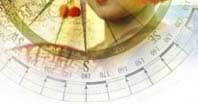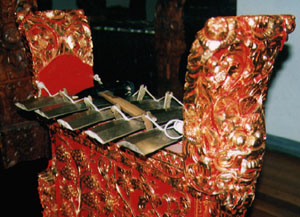|
The music of Bali is extremely complex and vibrant. The
original purpose of music here again is to serve religious
beliefs, accompanying dances or wayang theaters. The traditional
Balinese orchestra, known as gamelan, is composed of various
forms of percussions, with notes overlapping and criss crossing
among the various kinds. There is a number of string and
woodwind instruments, but most of the players, which can
range from a few to several dozen, sit behind various kinds
of metallophones, gongs, and xylophones. Each gamelan has
its own tuning, preventing instruments from being interchanged
from one gamelan to another.
The music of Bali has inspired well known composers from
all around the world. Bela Bartok titled his No.109 piece
"From the island of Bali." It is also said that
Debussy, after having met a Balinese musician and seen a
Balinese orchestra performed in Europe, is very impressed
and affected, and that much of his later works contain distinct
colors of Balinese music.
But Colin McPhee (1900-1964), a Montreal-born author and
musician, was probably the one most affected as well as
most influential in Balinese music. Story has it that his
life-changing moment happened in New York, when he first
encounter a vinyl of Balinese gamelan. He set sail, so to
speak, to Bali, and immersed himself in learning about and
contributing to Balinese music. His compendium of Balinese
music is an extremely well-researched collection of the
various aspects of Balinese music. His Tabuh-tabuhan: toccata
for orchestra won him the coveted Pulitzer Prize.
Tabuh-tabuhan is a collective noun that literally translates
into a collection of percussion instrument - the Balinese
gamelan. It consists of three movements: Ostinatos, Nocturne,
and Finale. McPhee's nuclear gamelan consists of two pianos,
celesta, xylophone, marimba, and glockenspiel, with special
Balinese gongs and cymbals added for certain sounds. Premiered
in Mexico in 1936, this piece fuses Balinese motifs, melodies,
and rhythms into a symphonic work. The signature of a Balinese
flute melody inspires the Nocturne, unmistakably similar
to what you can hear as you walk by the village temple today.
The syncopated finale is kindred to the tapestry formed
by the village orchestra accompanying a popular dance.
McPhee was also mostly responsible for the introduction
of Balinese music and gamelan into the U.S. Many ethnomusicology
departments in various U.S. universities today as well as
performance groups have in-house gamelan, and fortunately,
some of them even have Web sites that you can visit (if
you know more, please send us email
):
- Gamelan Sekar Jaya
This group is a non-profit organization that studies and
performs Balinese music and dances, based in the San Francisco
Bay Area and founded in 1979 by I Wayan Suweca, Rachel
Cooper and Michael Tenzer.
- Bali &
Beyond
This is a group of Los Angeles artists performing programs
related to Indonesian culture.
- Gamelan
Galak Tika
Housed at MIT, Gamelan Galak Tika was founded in September
1993 by director Evan Ziporyn, Associate Professor of
Music at MIT, for the purpose of studying and performing
both traditional and modern Balinese music and dance.
The Gamelan Gunung Sari of Peliatan, Bali is making a US
Tour this year. Check their schedule
here, and if it's coming near you, go see it!
|







